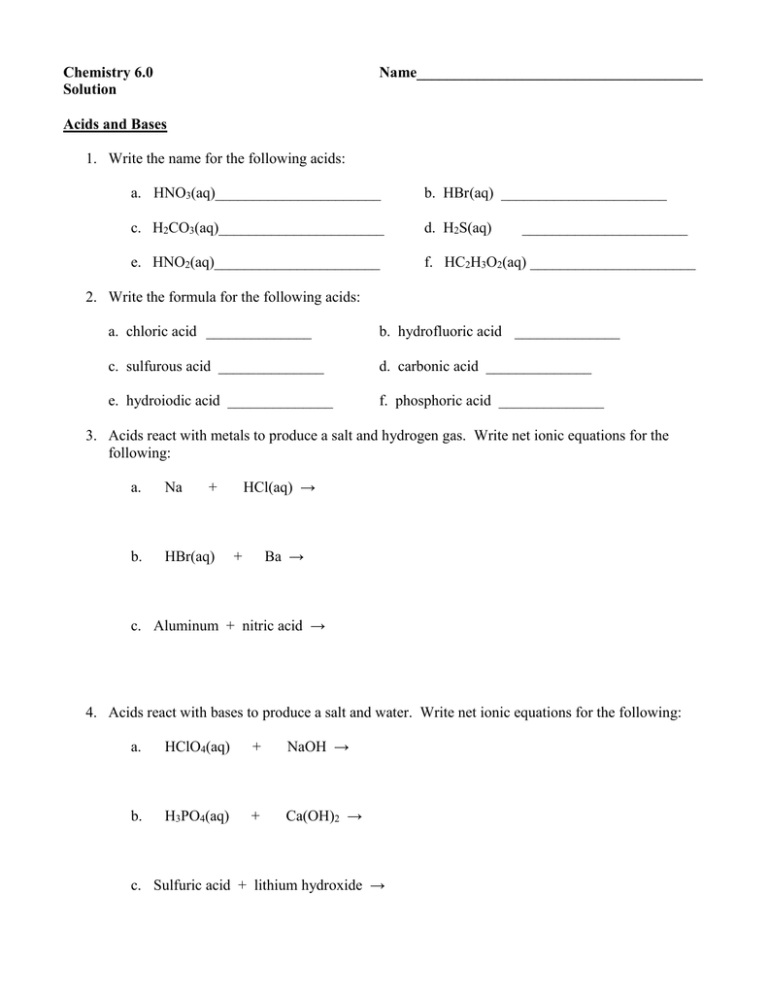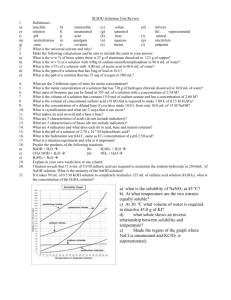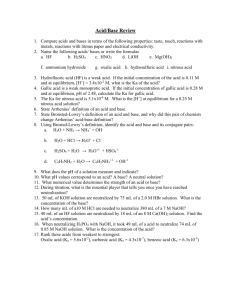Chemistry 6.0 Name______________________________________ Solution
advertisement

Chemistry 6.0 Solution Name______________________________________ Acids and Bases 1. Write the name for the following acids: a. HNO3(aq)______________________ b. HBr (aq) ______________________ c. H2CO3(aq)______________________ d. H2S(aq) e. HNO2(aq)______________________ f. HC2H3O2(aq) ______________________ ______________________ 2. Write the formula for the following acids: a. chloric acid ______________ b. hydrofluoric acid ______________ c. sulfurous acid ______________ d. carbonic acid ______________ e. hydroiodic acid ______________ f. phosphoric acid ______________ 3. Acids react with metals to produce a salt and hydrogen gas. Write net ionic equations for the following: a. Na b. HBr(aq) HCl(aq) → + Ba → + c. Aluminum + nitric acid → 4. Acids react with bases to produce a salt and water. Write net ionic equations for the following: a. HClO4(aq) + NaOH → b. H3PO4(aq) + Ca(OH)2 → c. Sulfuric acid + lithium hydroxide → 2 5. Write the formula for the acid and base required to produce the salt, Cs2CrO4 in a neutralization reaction. acid:___________________________ base:____________________________ Properties of Acids and Bases 6. Write the appropriate term that fits the description provided. a.___________________ An ionic compound formed when an acid reacts with a base. b.___________________ The reaction between an acid and a base. c.___________________ A substance that conducts an electric current when in solution. d.___________________ A proton donor. e.___________________ A substance that has different colors in acids and bases. f.___________________ A substance that supplies hydroxide ions in solution. g.___________________ The removal of a hydrogen ion from an acid. h.___________________ The ion formed when a proton is added to a water molecule. 7. Write A for acid, B for base or an X if the indicated property can apply to either. _____ feels slippery _____ sour taste _____ stings in open wounds _____ reacts with most metals _____ phenolphthalein is colorless _____ litmus paper turns red _____ does not react with metals _____ methyl orange turns orange _____ is an electrolyte _____ has a bitter taste _____ can produce a salt in some reactions _____ has a pH > 7 8. What is the conjugate acid of: a. NO2− b. NH3 c. HPO4−2 d. CH3NH2 9. What is the conjugate base of: a. H2SeO3 b. HBrO4 c. HPO4−2 d. NH4+ 3 10. For the following reactions, identify the acid (A), base (B), conjugate acid (CA) and conjugate base (CB) a. HNO2 + H2O → H3O+ + NO2− b. HCN + H2O → CN− + H3O+ c. H2O + H2O → H3O+ + OH− d. H2O + F- → OH− + HF e. NH4+ + H2O → NH3 + H3O+ f. CO3−2 + H2O → HCO3- + OH− 11. Explain the following given the equation: NH3 + H2O → NH4+ + OH− a. Ammonia is a Bronsted-Lowry base: b. Water is a Bronsted- Lowry acid: c. Water is not an Arrhenius acid: 4 pH 12. Determine the following quantities for a 0.00045 M HCl solution: b. [OH−] a. [H3O+] c. pH d. pOH 13. Determine the following quantities for a 0.0034 M NaOH solution: b. [OH−] a. [H3O+] c. pH d. pOH 14. Calculate pH for the following and identify if the solution is acidic, basic or neutral: -9 b. [OH−] = 1.07 x 10−8 M a. [H3O+] = 2.9 x 10 M c. pOH = 12.1 15. Calculate [H3O+] for the following and identify if the solution in acidic, basic or neutral: -3 a. [OH−] = 5.0 x 10 M b. pH = 3.7 c. pH = 11.2 d. pOH= 6.0 5 − 16. Given the pH values determine the [OH ]. Indicate if acidic, basic or neutral. a) 7.00 b) 11.35 c) 4.15 d) 5.09 17. Determine the pH of each solution. Indicate if acidic, basic or neutral. a) 2.5 x 10−5 M H3O+ b) 4.0 x 10−7 M OH− c) 3.0 x 10−3 M H+ 18. Given the concentration for the following solutions, solve for the [H+] or [OH-]. Indicate if acidic, basic or neutral. a) 2.9 x 10−7 M H+ b) 4.6 x 10−9 M OH− c) 8.91 x 10-4 M H+ Dilutions 1. What volume of concentrated 18 M sulfuric acid is needed to prepare 250 mL of a 6.0 M solution? 2. If 14.6 mL of water were added to 25.0 mL of a 0.100 M acetic acid solution, what molarity would the solution become? 3. To what volume should 25 mL of 15 M nitric acid be diluted to prepare a 3.0 M solution? 6 4. To how much water should 50. mL of 12 M hydrochloric acid be added to produce a 4.0 M solution? 5. Describe how to prepare 100.mL of a 0.500 M NaOH solution beginning with a 3.00M NaOH stock solution. 6. Describe how to prepare 100.mL of a 0.500 M NaOH solution beginning with solid NaOH. Solution Stoichiometry 1) If 25.0 g of a 15.6 % sodium sulfate solution is completely reacted with barium nitrate, how many grams of precipitate will form? 7 2) Solve the following problems using the equation: 2 Fe(s) + 3 H2SO4(aq)→ Fe2(SO4)3(aq) + 3 H2(g) a. If excess iron is added to 25.0 mL of a 0.100 M sulfuric acid solution, how many molecules of hydrogen gas will be produced? b. If 0.31 g of iron react completely, determine the molarity of the resulting iron(III) sulfate solution. Assume the addition of iron does not significantly alter the solution volume. c. What volume of hydrogen gas at 25°C and 624 torr will be produced when 25.6 g of iron is added to 20.0 mL of a 0.150 M sulfuric acid solution? 3) Enough Pb(NO3)2 is added to 450 g of water to prepare a 1.50 m solution. If NaI is added in excess, how many moles of lead(II) iodide are produced? 4) If 51.0 mL of 0.250 M calcium nitrate is combined with 62.3 mL of 0.370 M sodium phosphate, calculate the mass of the precipitate. 8 5) Hydrogen gas is produced in a eudiometer tube from the reaction between magnesium and 6.0 M hydrochloric acid by the method of water displacement. Once the reaction is complete, the eudiometer is adjusted so that the water level inside the tube is equal to the water level outside of the tube. The hydrogen’s volume is determined to be 34.5 mL. The barometric pressure is 751 torr and the temperature of the hydrogen (determined by measuring the water temperature) is 45°C. a. How many grams of magnesium ribbon reacted? b. How many milliliters of the acid solution reacted? 6) If 24.55 g of solid aluminum hydroxide is required to completely neutralize 27.1 mL of a sulfuric acid solution, what is the molarity of the acid? Titrations 1) 139.8 mL of 1.50 M KOH is required to neutralize 50.0 mL of HNO3. What is the molarity of the HNO3? 2) Determine the molarity of hydrochloric acid given the following data: Initial buret reading (mL) Final buret reading (mL) HCl 1.5 37.6 1.75 M NaOH 0 22.3 9 3) 24.9 mL of 2.88 M Ca(OH)2 completely neutralizes 38.9 mL of an HBr solution. What is the molarity of the HBr? 4) Determine the molarity of strontium hydroxide given the following data: Initial buret reading (mL) Final buret reading (mL) Sr(OH)2 11.0 49.2 0.202 M HClO4 5.0 38.6 Determining ∆H From Calorimetry Assume that the density and specific heat of all solutions are the same as water. 1. When 12.8 g of KCl dissolves in 75.0 g of water in a calorimeter, the temperature drops from 31.0°C to 21.6°C. Write the equation for this process and calculate the ΔH in kJ/mol. 2. Silver chloride can be precipitated by adding solid silver nitrate to a sodium chloride solution. If 0.956 g of silver nitrate is added to 21.0 mL of a sodium chloride solution, the temperature increases from 25.0°C to 27.58°C. a. Calculate the ΔH for this process. 10 b. Write the net ionic, thermochemical equation for this reaction. c. Draw an energy diagram for this reaction. d. Calculate the enthalpy change for this reaction that is required to precipitate 3.55 g of silver chloride. 3. When 25.7 g of NaI dissolves in 80.0 g of water in a calorimeter, the temperature rises from 20.5°C to 24.4°C. Calculate the enthalpy change in kJ/mol. 11 4. When 16.9 g of NaOH reacts with 50.0 g of an HCl solution, the temperature rises from 22.4°C to 31.0°C. Assume the NaOH is the limiting reagent. a. Calculate ΔH b. In a separate experiment, 35.8 g of NaOH is reacted with HCl. The heat released is applied to a block of ice at 0°C. How many grams of the ice will melt? 5. When 19.2 g of KCN dissolves in 65.0 g of water, the temperature drops from 28.1°C to 15.4°C. Write the thermochemical equation for this process. 6. Answer the questions below using the 3 given equations: Reaction 1: Reaction 2: Reaction 3: 2 Na + H2SO4 Na2SO4 + H2 Na + H2O(l) NaOH + ½ H2 H2SO4 (l) H2O(l) + SO3(g) H = -577.5 kJ H = ??? H = ??? a. Determine the enthalpy change of reaction 2, in kJ/mol, given the following experimental data: When 1.50 g of sodium is placed in a calorimeter containing 40.0 g of water, the temperature increases from 22.0°C to 91.0°C. (Assume the hydrogen produced in the reaction is contained in the calorimeter and that the specific heat of the solution is the same as it is for water). 12 b. Determine the enthalpy change of reaction 3 by using the enthalpies of formation. c. Apply Hess’s Law to reactions 1, 2, and 3 to determine the enthalpy change for: 2NaOH + SO3 Na2SO4 + H2O(l) d. Write the thermochemical equation for: i. Reaction 1: ii. Reaction 3: e. Write the equation for reaction 2 in H notation. f. Is reaction 2 endothermic or exothermic? Cite two reasons for your choice. g. In reaction 3, do the reactants or the products have a lower enthalpy? h. Draw the energy diagram for: Reaction 1 Reaction 3 i. How many kilojoules of thermal energy are transferred when 2.09 L of hydrogen gas at STP is produced in reaction 2? j. How many grams of sodium would be required to react in reaction 1 if 127 kJ of thermal energy is released? 13 Review 1. Calculate the pH of the following and indicate if acidic, basic or neutral: a. [H3O+] = 1.00 x 10-7 M b. [OH−] = 8.39 x 10-2 M c. pOH = 9.0 d. 0.071M HCl a. 0.14 M NaOH 2. Calculate [H3O+] for each of the following and indicate if acidic, basic or neutral: a. pH = 4.91 b. pOH = 3.62 c. [OH-] = 2.4 x 10−6 M 3. For each of the following reactions, label the acid, base, conjugate acid, and conjugate base. a. NH3 + CH3COOH ↔ NH4+ + CH3COO− b. HSO4− + H2O ↔ H3O+ + SO4−2 4. What is the conjugate acid of: a. IO3− b. HC2O4− 14 5. What is the conjugate base of: a. C5H5NH+ b. HC2O4− 7. How would you prepare the following solutions: a. 250 mL of 0.500M HCl(aq) from a 12.0 M stock solution b. 30.0 mL of 2.50 M NaOH from solid NaOH 8. Complete and balance: Fe(OH)3(s) + H2SO4(aq) → b. How many grams of iron (III) hydroxide are required to neutralize 20.0 mL of 6.0M sulfuric acid? c. If 45.6 mL of a sulfuric acid solution of unknown concentration is required to titrate 20.36 g of the iron(III) hydroxide, what is the molarity of the acid? d. Write the net ionic equation for the reaction. 15 7) Determine the molarity of a phosphoric acid solution if 14.9 mL of the solution is titrated with 38.1 mL of 2.50 M barium hydroxide. 8) When 30.0 mL of 3.00 M sodium hydroxide is reacted with 45.0 mL of 2.50 M iron(III) chloride, 2.69 g of precipitate is recovered. Determine the percent yield of the reaction. 9) How many formula units of the precipitate are produced by the addition of 2.59 g sodium carbonate to 25.0 mL of a 0.750 M iron(III) chloride solution? 16 Cumulative Review 1. Convert 188.2 km/s to in/yr. 2. Perform each of the following calculations and report the answer in scientific notation and with the correct significant figures. a. 265.3 x 0.0564 __________________________ b. (36.25 − 74.1)/120 __________________________ c. 1650 + (284.8 x 0.136) __________________________ 3. The density of lead is known to be 11.35 g/cm3. If 4.42 x 1023 atoms of lead are placed into a graduated cylinder with 26.4 mL of water, what will be the new volume of water in the cylinder? 4. Classify the following as element, compound, mixture (hetero) or solution. Classification air mint chocolate chip ice cream nitrogen gas table salt 5. Sate the number of p+, n0, and e− in each of the following: -2 a. 202 b. 34 80 Hg 16 S c. 143 3+ 59 Pr 6. What is the common charge on the following elements when they form ions? a. aluminum _______ c. chlorine _______ c. rubidium _______ 7. A sample of curium-242 has a half-life of 160 days and undergoes alpha decay. Write the nuclear equation for this process. A 0.150 gram sample of curium exists after undergoing alpha decay for 3.95 years. What was the original sample mass of the curium-242? 17 8. Write the appropriate name or formula for each of the following. Rb2C2O4 dichlorine monoxide SiCl4 barium nitrite CuCl2 • 2 H2O molybdous acid H3PO3 iron(III) nitrate nonahydrate Mo(SO3)3 formic acid H2Se(aq) tin(II) hydroxide 9. Write nuclear equations for the following: a. the production of bismuth-209 from an electron capture. b. the release of a beta particle by lead-210. 10. Determine the number of water molecules in 63.52 grams of cobalt(II) nitrate hexahydrate. 11. Determine the molecular formula for a substance that contains 52.11% C, 13.14% H, and 34.75% O and has a molar mass of 138 g/mol. 12. Write balanced equations for the following: a. Powdered magnesium oxide is placed into water. b. A sample of aluminum carbonate is vigorously heated in a crucible. 18 c. Magnesium metal is heated in the presence of iodine gas. d. Solutions of calcium chloride and potassium carbonate are mixed e. A sample of iron(III) hydroxide is intensely heated. f. Hydrogen sulfide gas is bubbled through a solution of iron(III) chloride. 13. A titration is performed where 26.5 mL of 1.15 M sulfuric acid is used to titrate 19.4 mL of potassium hydroxide. What is the molarity of the potassium hydroxide. Write the net ionic equation for the reaction. 14. Find the mass of 62.5 Liters of oxygen gas at STP. 15. What is the pressure, in kPa, exerted by 42.5 grams of xenon gas at a temperature of 75.0°C and a volume of 2.65 Liters? 19 16. A sample of sulfur dioxide gas occupies 56.2 mL at a pressure of 772 mm and a temperature of 95.6°C. What is the volume of the gas at STP? 17. A 3.25 gram sample of calcium carbide, CaC2, reacts with water to produce acetylene gas (ethyne) and aqueous calcium hydroxide. If the acetylene is collected over water at 17°C and 0.974 atm, how many mL of acetylene are produced if the yield for the reaction is 92.5%? 18. A sample of helium effuses through a porous container 6.50 times faster than does unknown gas X. What is the molar mass of the unknown gas? 19. Write the equation for the dissociation of aluminum oxalate. 20 20. Write the net ionic equation for the reaction between barium nitrate and potassium sulfate. 21. A solution containing 14.0 g of silver nitrate is added to a solution containing 4.83 g of calcium chloride. Determine the mass of solid formed and the amount of excess reactant remaining. Write the net ionic equation for the reaction.




